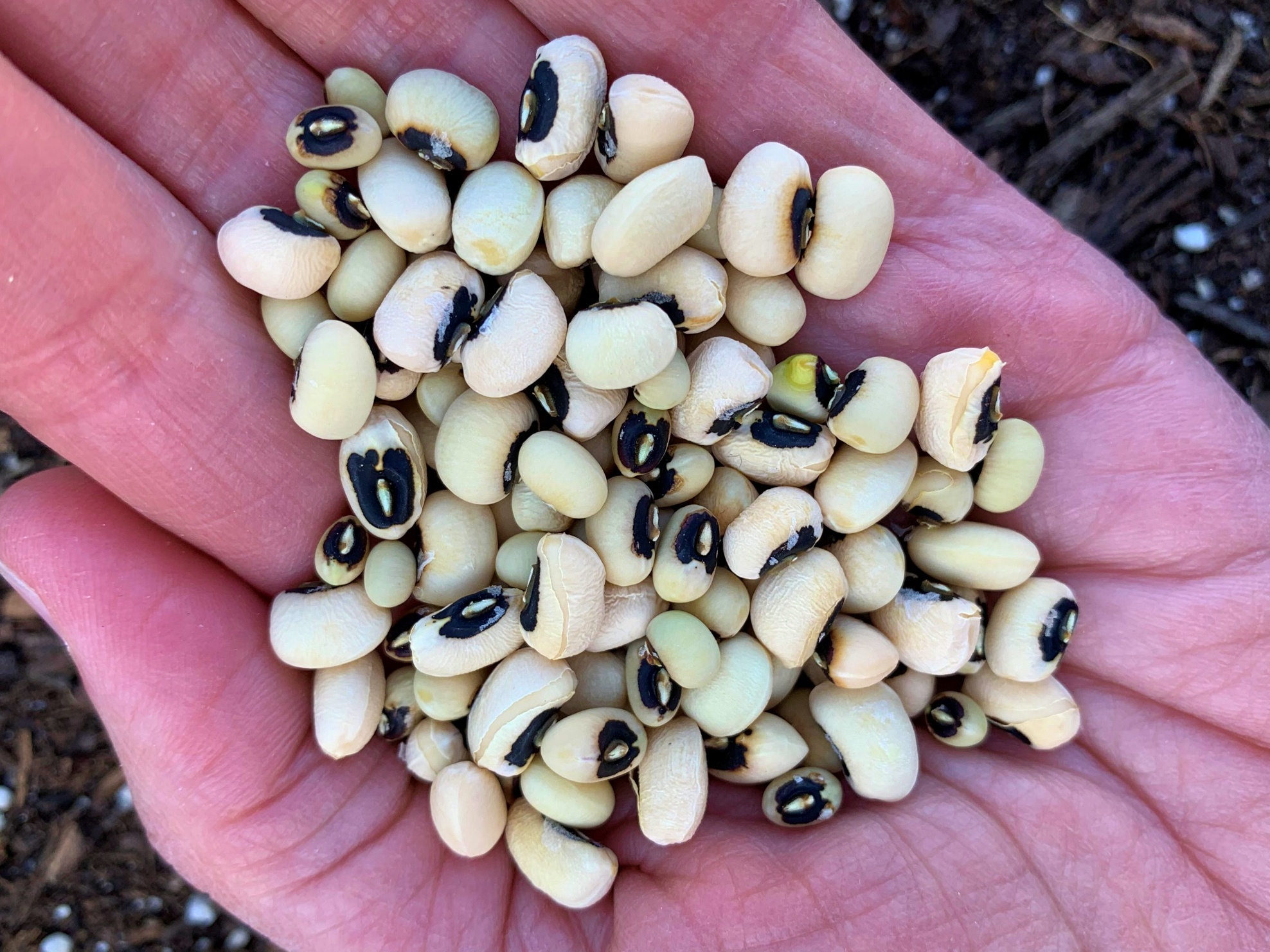Black-eyed peas are a variety of cowpea and a member of the legume family. In addition to being called black-eyed peas and cowpeas, they are also referred to as Southern peas, crowder peas, and field peas. Ironically, however, they are not peas, rather they are beans.
The kidney-shaped legumes are tan with a black spot or “eye” where the pea (bean) was attached to the pod. They are cousins, if you will, to the lesser-known purple hull pea, so named because it grows in a purple hull.
This high protein, high fiber, Southern staple is more versatile than other legumes because it can be eaten at every stage of development. In this post, you will learn everything you need to know to grow delicious black-eyed peas the easy peasy way.

Legumes Add Nitrogen to the Soil
All plants take up nutrients from the soil, but legumes also put nitrogen back into the soil via a beneficial soil bacterium that attaches itself to the plant’s roots, enabling the plant to absorb nitrogen gas from the air. The nitrogen, which is then stored in root nodules, benefits, not only the soil and host plant, but also nearby plants, and the next rotation of crops planted in that soil the following season. (Note: Beneficial bacterial nodules are not to be confused with root knot nematode damage)
This article contains affiliate links. If you make a purchase using one of these links, I will receive a very small commission at no additional cost to you, and it will help me maintain this website. Rest assured, I only recommend products I actually like!
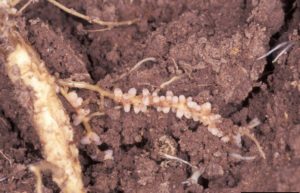
Rhizobium, the amazing bacteria that makes the bonus nitrogen possible, may not be present in the soil in sufficient numbers, therefore, some gardeners inoculate the seeds with Rhizobium before planting, increasing their chances of growing healthier plants with a greater yield. The legume-specific inoculant is available online or some seed companies sell pre-inoculated seeds.
Sun, Soil, Water, and Fertilizer
Unlike sugar snap or snow peas which are cool weather crops, black-eyed peas are a warm-weather crop that cannot tolerate cold temperatures. About four weeks after the last expected spring frost, plant seeds when the soil temperature is a consistent 65o F (18 o C). (You can learn more about the proper temperature for planting seeds in this helpful arttcle.) They prefer a soil pH of 5.8 to 7.0.
In beds, sow seeds in well-draining soil ½ to 1 inch (1.3 to 2.5 cm) deep and 4 to 6 inches (10 to 15 cm) apart, in rows about 2 to 3 feet (.6 to .9 meters) apart. Containers or grow bags need to be at least 12 inches (30 cm) deep and have good drainage. Sow about 3 to 4 seeds per container. Most varieties grow between 2 and 6 feet tall. If growing a vining variety, you may need to add a trellis or tomato cage to help support the plant as it grows.
Like okra, black-eyed peas are susceptible to root disturbance. For this reason, many gardens prefer not to start seeds indoors, but to simply sow directly. If you choose to get a head start on the season, start seeds using grow lights and a heat mat 4 to 6 weeks before the last frost date in the spring.
In warmer climates, two plantings are possible, one in the spring and the other towards the end of the summer. For example, in zone 8, I can direct sow in March and August/September.
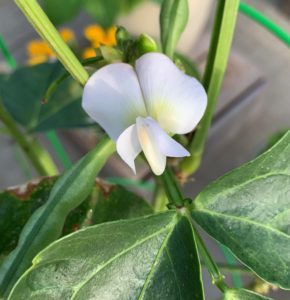
Black-eyed pea blossom, Okra In My Garden
Black-eyed peas require eight hours of full sun but may be able to tolerate a touch of shade in the afternoon. They like moist, but not soggy soil. Water when the top inch of soil is dry to the touch.
Black-eyed peas may not need fertilizer if grown in good soil. However, if growing in containers you may need to use a liquid fertilizer that is higher in nitrogen like fish emulsion if the plant looks pale. Too much nitrogen, however, can result in lush foliage but fewer pods. If the plant has a good green color, a vegetable fertilizer will do. If you use an inoculant, you should not need fertilizer.
If there are flowers but no pods, it is often a sign of a calcium or phosphorus deficiency or possibly caused by heat or water stress.
When to Harvest Black Eyed Peas
Black-eyed peas are mature and ready to harvest in about 60 to 90 days, depending on the variety. However, the good thing about this legume is that you can harvest and consume them at any time during the pods’ development. The younger green pods will be tender. Eat them as you would green beans. Mature pods will also be green, but they will be longer and bulging from the swollen peas inside. Shell the fresh peas and boil them until tender. Or allow the pods to remain until they are brown and dried out. Shell the peas and save them for another day or soak them and then boil them for eating. If you opt to store the peas, make sure they are completely dry before storing them in an airtight container. Be sure to save a handful of peas to use as next year’s seed!
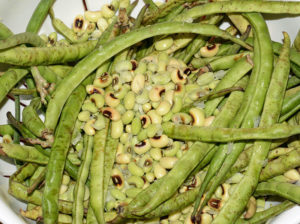
Pests and Diseases
Legumes are subject to some of the same pests as other plants such as aphids, leafhoppers, cutworms, and root knot nematodes. But they are also the favorite of the Mexican bean beetle, which is a yellow to copper-colored beetle that is similar in shape to the ladybug but larger in size. The best way to deal with this pest is to handpick them off the plant. Another option would be to spray them with a Neem oil solution. You can learn more about making your own pest-control spray in this helpful article.
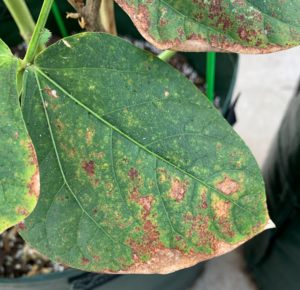
Powdery mildew, downy mildew, and bean rust can plague black-eyed peas. Follow the links to learn how to treat these issues organically.
Bean mosaic virus, which is characterized by puckered leaves with curled edges, and light and dark mosaic patterned leaves, is also a threat. There is no cure and affected plants must be pulled and destroyed. Do not compost them as the virus will more than likely survive the process. Crop rotation is a must if you want to thwart this and other diseases.
Varieties
Black-eyed peas are available in bush and climbing varieties. California Blackeye is a popular bush variety that produces six to eight-inch pods. It grows to a height of about 1.5 to 2 feet. Cream Pea Elite is a similar cultivar with peas that are lighter in color and easy to shell.

Queen Anne is known for being a good producer. It is compact and produces 7 to 9 inch pods in about 60 days. If you want to try a purple hull pea, Big Boy is a crowd favorite.
If you have never tried growing black-eyed peas, it truly is easy! This spring or summer would be a great time to start. Just be sure to save some to eat on New Year’s Day!
Thank you for reading this article! If you found it helpful, please consider sharing it with others via email and social media!
